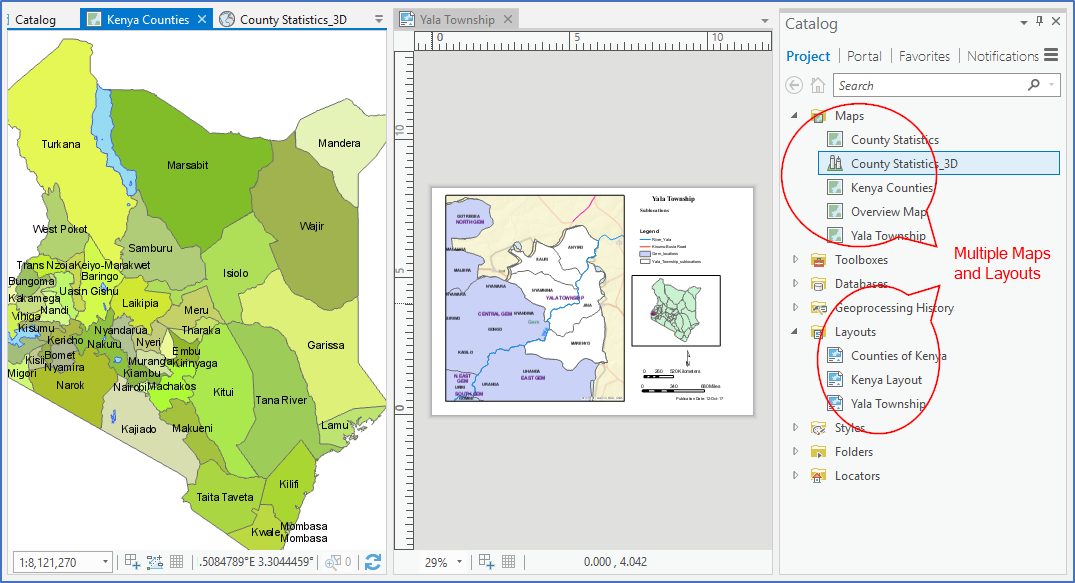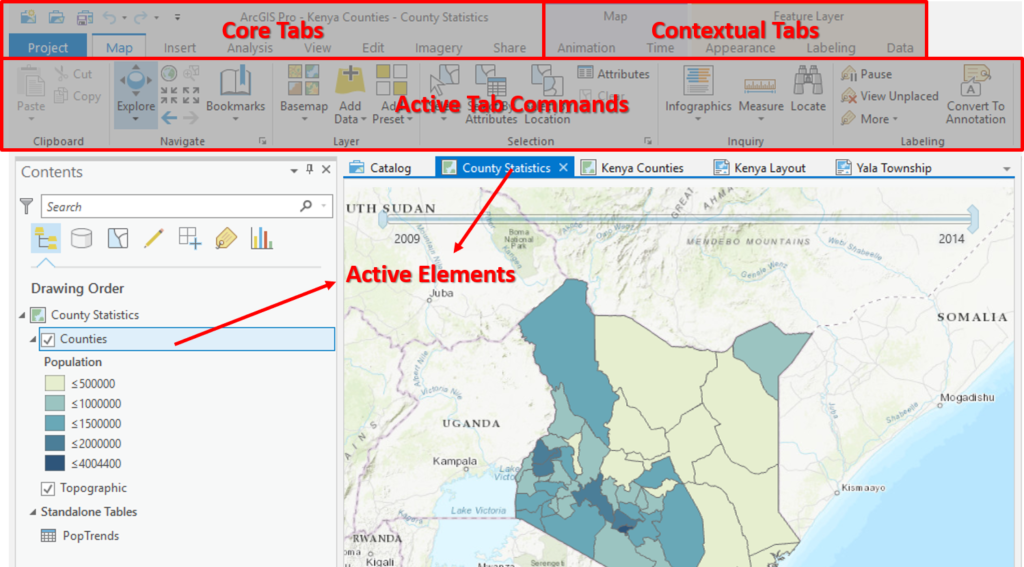
ArcGIS Pro is a 64-bit, multithreaded GIS desktop application that runs on Windows. It was first released in January 2015, but ArcMap appears to have remained the most popular ArcGIS Desktop application. In June 2017 Esri released ArcGIS Pro 2.0 and this might be an opportune time to make the switch to the new application.
I have used and taught ArcMap for many years, but turned to ArcGIS Pro in my search for an ArcGIS Online authoring tool. I needed some time to get used to ArcGIS Pro, but have come to appreciate the intuitive user interface, with its powerful functionality and improved performance. In this article I present 5 major reasons for making ArcGIS Pro your software of choice.
1. Project-based Application
ArcGIS Pro is a project-based application that stores or references all the files and documents needed in a project. On starting ArcGIS Pro you can open an existing project, or create a new project based on a relevant project template.

Each ArcGIS Pro project creates a project file (.aprx), file geodatabase (.gdb), and toolbox (.tbx) and stores or references any additional content that is added to the project such as folder and server connections, tools, and styles on your computer.

An ArcMap map document is limited to one map and layout, to the frustration of users who use multiple maps and layouts in their projects. They can now use ArcGIS Pro and migrate their map documents and scenes to a reduced number of projects.

2. Ribbon Interface
ArcGIS Pro has a modern and easy-to-use ribbon interface similar to modern Microsoft applications like Word and Excel. The tabs in the ribbon interface group commands in an intuitive manner and additional commands and options can be accessed with the click of a button.
The core tabs remain visible throughout, while contextual tabs appear based on what’s added to the view or selected in the table of contents. The ribbon interface only occupies the top portion of the application window and can even be minimized.

Compare the use of a single ribbon interface to the use of multiple toolbars in ArcMap which clutter the user interface and are never in the place that you expect them to be.
3. 64-bit, Multithreaded Application
ArcGIS Pro is a modern 64-bit multithreaded application that takes advantage of all your computing resources and runs fast. It executes many of its processes in modeless panes (e.g. Geoprocessing pane) which operate independently from each other. While running a tool in the geoprocessing pane, you can continue to navigate the view or add a layer to the content pane.

In ArcMap most commands are executed through modular windows that pop-up and stop you from doing any other work. Precious time is lost waiting for a process to complete or switching between your view, table of contents and tools.
4. 2D/3D Integrated Environment
ArcGIS Pro provides a unified environment for working with 2D and 3D data, so you don’t keep switching between different applications. ArcGIS Pro allows you to view 2D maps alongside 3D scenes which can either be local or global. These views can be linked to one another so that the extent and center of the views are identical.

To create 3D scenes with realistic detail one can import textures from a CityEngine rule package which can be applied to extruded buildings. Individual 3D features designed in CityEngine can also be imported to create a stunning virtual reality.

5. Integration with ArcGIS Platform
ArcGIS Pro is tightly integrated with the ArcGIS platform. For starters you can easily import your previous work from ArcMap through map documents, scenes, globes, geoprocessing scripts and models, and styles.

ArcGIS Pro can be licensed for offline use, but by default it connects to an ArcGIS Online and/or enterprise portal and is authorized by a named user license.

Through a portal ArcGIS Pro has access to a wealth of content and services, such as private, organizational, and public web maps and layers, and Esri’s geocoding service, demographics, and Living Atlas of the World.

ArcGIS Pro is the prime application for authoring content and publishing it to an ArcGIS Online or enterprise portal. With ArcGIS Pro you can configure pop-ups, share web maps and layers, share 3D scenes and share layer, map, and project packages in a few easy steps.

Conclusion
Here you have it, 5 reasons for upgrading to ArcGIS Pro based on its product design and architecture. Which one has convinced you to switch to ArcGIS Pro or give it at least a try? Leave a comment to let us know and feel free to ask any question or concern that you might have.
Resources
If you have an ArcGIS Desktop license you can test ArcGIS Pro alongside ArcMap. If you don’t have a license, simply sign up for a 21-day ArcGIS Pro free trial. With ArcGIS Pro up and running you might want to go through the following foundational learning resources.
- ArcGIS Pro: An Introduction – Technical Workshop
- Get Started with ArcGIS Pro – Tutorial
- Getting Started with ArcGIS Pro – Web Course
- Going Pro: ArcGIS Pro Essentials for ArcMap Users – Training Seminar
